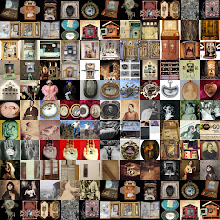
The use of wax to model figures has very ancient origins, in art and for religious purposses: statues of saints, cribs and offerings. During the Renaissance, in Florence, there where many wax figures in churches, and it is in the 17th century that the first wax figures for scientific purposses originate. There was a tradition of illustrating anatomical treatises with artworks by famous renaissance artists like Leonardo, Miguel Angel, Tiziano or Raphael.
A school of wax modelling based on dissecton arises in Bolonia, with art workshop and museum (La Specola, 1771-1893) using corpses from a nearby hospital with the consent of the Pope. Here the surgeon/anatomist and the sculptor worked together to produce extremelly accurate representations. The modelling and dissection tools side by side. Displayed in the museum they conformed a three dimensional anatomical treatise, with numbered parts and corresponding explanatory texts. The only full figure with separate parts is the 'venere medicea' a lying wax woman that can be opened and her insides revealed layer after layer.


This unique figure is the star of the museum, where artist and anatomist have joint efforts to produce the anatomical object par excellence: the pregnant woman. Before opened, she lies virginal in a bed of pleated silk, her wavy hair framing her eroticised nudity, a pearl necklace against her soft neck, her head turned in a gesture of pain, pleasure or religious ecstasy. As we transgress her unity and access the insides, we view the perfectly functional and fitting organism (compendium of organised and conceptualised delineated parts), the beauty of divine order, no fat or undecipherated chaotic mass of guts. Our gaze derives pleasure from the vision of self-explanatory systems layer after layer until we reach the core: the uterus. Like a gem at the core of our quest, it opens before our eyes to unveil the mystery of conception.

The artificial skin is permeated with feminity in a blend of beauty ideal and erotic appeal. Beyond the epidermis, scientific discourse reins and moulds the material into rationalised units. The body lends itself to scrutiny, under an omnipresent eternal gaze. It is killed, all it's processes and vital secrets petrified, the intimate exposed, the self is no where inhabiting, no place is left for it to hide, it does not exist. There is no blood pumping through the veins, no agency infused in the flesh, it is meat, not personhood. The body is forever excised from us.

The vagina, the opening of the body that brings forth life and forebodes death (menstruation), is denied agency, and by extension the whole body becomes passive and feminized. The cutting tool in the dissector's hand defines agency at one extreme, and matter on the other. The cut itself is an artificial replacement for the original aperture. The body's entrance is forced open beyond mortality, to proove the superiority of the mind.
Historical context and images: Encyclopedia Anatomica: Museo La Specola Florence, Taschen.


